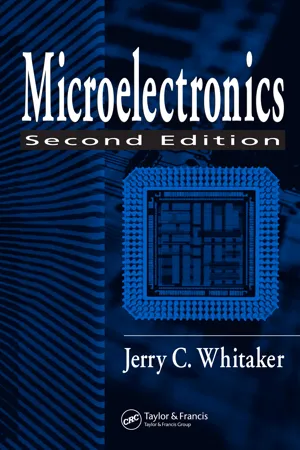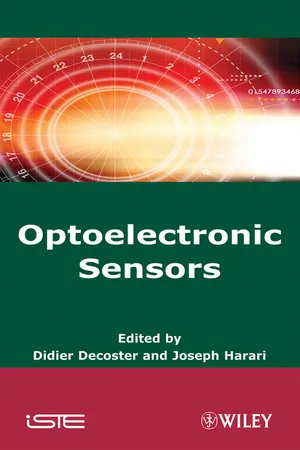Physics
Doped Semiconductor
Doped semiconductor refers to a semiconductor material that has been intentionally impurity-doped to alter its electrical properties. This process involves adding small amounts of specific elements, such as phosphorus or boron, to the semiconductor crystal lattice. Doping can increase the semiconductor's conductivity, making it useful for various electronic applications like transistors and diodes.
Written by Perlego with AI-assistance
6 Key excerpts on "Doped Semiconductor"
Learn about this page
Index pages curate the most relevant extracts from our library of academic textbooks. They’ve been created using an in-house natural language model (NLM), each adding context and meaning to key research topics.
- eBook - ePub
- Jerry C. Whitaker(Author)
- 2018(Publication Date)
- CRC Press(Publisher)
hole. Electrons from neighboring covalent bonds can easily move into an adjacent bond with an electron vacancy, or hole, and thus the hold can move from one covalent bond to an adjacent bond. As this process continues, we can say that the hole is moving through the material. These holes act as if they have a positive charge equal in magnitude to the electron charge, and they can also contribute to the electrical conductivity. Thus, in a semiconductor there are two types of mobile electrical charge carriers that can contribute to the electrical conductivity, the free electrons and the holes. Since the electrons and holes are generated in equal numbers, and recombine in equal numbers, the free electron and hole populations are equal.In the extrinsic or Doped Semiconductor, impurities are purposely added to modify the electronic characteristics. In the case of silicon, every silicon atom shares its four valence electrons with each of its four nearest neighbors in covalent bonds. If an impurity or dopant atom with a valency of five, such as phosphorus, is substituted for silicon, four of the five valence electrons of the dopant atom will be held in covalent bonds. The extra, or fifth electron will not be in a covalent bond, and is loosely held. At room temperature, almost all of these extra electrons will have broken loose from their parent atoms, and become free electrons. These pentavalent dopants thus donate free electrons to the semiconductor and are called donors. These donated electrons upset the balance between the electron and hole populations, so there are now more electrons than holes. This is now called an N-type semiconductor, in which the electrons are the majority carriers, and holes are the minority carriers. In an N-type semiconductor the free electron concentration is generally many orders of magnitude larger than the hole concentration.If an impurity or dopant atom with a valency of three, such as boron, is substituted for silicon, three of the four valence electrons of the dopant atom will be held in covalent bonds. One of the covalent bonds will be missing an electron. An electron from a neighboring silicon-to-silicon covalent bond, however, can easily jump into this electron vacancy, thereby creating a vacancy, or hole, in the silicon-to-silicon covalent bond. Thus, these trivalent dopants accept free electrons, thereby generating holes, and are called acceptors. These additional holes upset the balance between the electron and hole populations, and so there are now more holes than electrons. This is called a P-type semiconductor - eBook - ePub
- Didier Decoster, Joseph Harari, Didier Decoster, Joseph Harari(Authors)
- 2013(Publication Date)
- Wiley-ISTE(Publisher)
Semiconductor materials are mostly divided into two large classes: elemental semiconductors (group IV of the periodic table): silicon, germanium, diamond, etc. and compound semiconductors: IV-IV (SiC), III-V (GaAs, InP, InSb, GaN) and II-VI (CdTe, ZnSe, ZnS, etc.). Impurities can be introduced into the volume of the semiconductor material and can modify its electrical conduction properties, sometimes considerably. An impurity is known as a donor when it easily releases a free electron into the conduction band. The characteristic energy level of the impurity is therefore in the bandgap, slightly below the conduction band. For example, in the case of compound semiconductors in group IV of the periodic table such as silicon, the main donor impurities are those which, being from group V of the periodic table (arsenic, phosphorous, etc.), are substituted in place of a silicon atom in the crystal structure: since silicon is tetravalent, these atoms naturally form four covalent bonds with the silicon atoms around them, and also easily give up their surplus electron to the crystal structure. These electrons become free to move, subject to a weak activation energy provided by thermal agitation. In this case we refer to n-type doping. In the case of silicon, a group III element incorporated into the crystal structure of silicon naturally forms three covalent bonds around it, and then completes its own outer-shell electronic structure by capturing an electron from its fourth nearestneighbor silicon atom, again subject to a weak thermal activation energy. Such an impurity is known as an acceptor, and doping with acceptors is known as p-type doping. A hole carrying a positive elementary charge and corresponding to a vacant energy state in the valence band is therefore left in the crystal structure of the silicon - eBook - ePub
Modern Manufacturing Technology
Spotlight on Future
- Jitendra Kumar Katiyar, Ranjeet Kumar Sahu(Authors)
- 2021(Publication Date)
- CRC Press(Publisher)
4 Ultrafine Electronic Devices Manufacturing TechniquesDOI: 10.1201/9781003203162-44.1 Semiconductor
Semiconductors are one of the electronic materials that behave in between conductors and insulators. They have higher electrical conductivity than insulators but lower conductivity than conductors at room temperature. The energy gap (band gap) of semiconductors lies in between 0 and 4 eV due to which they have moderate conductivity and carrier density at room temperature. They strongly absorb light, i.e., near IR and visible regions, and having energies above the energy gap. The semiconductor materials are Si, Ge, Ga, As, In, Sb, Se, etc., in which Si and Ge lie in the IV column of the periodic table known as elemental semiconductors. Further, Zn, Cd, Ga, In, As, Sb, Se and Te lie in II, III, V and VI columns of the periodic table, respectively. The combination of II and VI, III and V column atoms gives the binary compound, i.e., known as compound semiconductors. There are also ternary (GaAsP) and quaternary (InGaAsP) compounds that are exited in semiconductors (Swaminathan, 2017 ; Groover, 2018 ). It is important to note that insulators at higher temperatures behave like semiconductors.4.1.1 Semiconductor Doping
Doping in semiconductors is very important to make it electrically conductive. This can be achieved by the addition of elements, known as impurities. This process is known as doping. For example, if arsenic is added to silicon as an impurity, then it behaves like a conductor. This is decided through the valence of electrons. It is noted that one valence electron remains in arsenic after bonding with silicon. This left electron results in the flow of current. Further, if more arsenic atoms are added, then a large number of free electrons are generated, resulting in low resistance due to which free flow of current. Interestingly, if a few boron atoms are added with arsenic, then a few electrons are absorbed by boron, causing high resistance due to which low flow of current. Therefore, it can be said that controlling dopants can control any resistance. Using diffusion and ion implantation techniques can carry the doping in the semiconductor. By using these techniques, n-type or p-type semiconductors are manufactured (Swaminathan, 2017 - eBook - ePub
- C R Robertson(Author)
- 2008(Publication Date)
- Routledge(Publisher)
Thus a sample of n-type semiconductor may be represented as consisting of a number of fixed positive ions with a corresponding number of free electrons, in addition to the thermally generated electron-hole pairs. This is shown in Fig. 9.5. Fig. 9.5 Fig. 9.6 The circuit action when a battery is connected across the material is illustrated in Fig. 9.6. Once more, only electrons flow around the external circuit, whilst within the semiconductor there will be movement of majority carriers in one direction and minority carriers in the opposite direction. 9.7 p-type Semiconductor In this case a trivalent impurity such as aluminium (Al), gallium (Ga), or indium (In) is introduced. These impurity atoms also join the covalent bonding system, but since they have only three valence electrons there will be a gap or hole in the bond where an electron would normally be required. Due to electron-hole pair generation in the lattice, this hole will soon become filled, and hence the hole will have effectively drifted off elsewhere in the lattice. Since each impurity atom will have accepted an extra electron into its valence band they are known as acceptor impurities, and become fixed negative ions. The result of the doping process is illustrated in Fig. 9.7. Fig. 9.7 We now have the situation whereby there will be more mobile holes than there are free electrons. Since holes are positive charge carriers, and they will be in the majority, the doped material is called p-type semiconductor, and it may be considered as consisting of a number of fixed negative ions and a corresponding number of mobile holes as shown in Fig. 9.8. Fig. 9.8 The circuit action when a battery is connected across the material is shown in Fig. 9.9. As the holes approach the left-hand end they are filled by incoming electrons from the battery. At the same time, fresh electron-hole pairs are generated; the electrons being swept to and out of the right-hand end, and the holes drift to the left-hand end to be filled - eBook - ePub
Organic Electronics 1
Materials and Physical Processes
- Thien-Phap Nguyen(Author)
- 2021(Publication Date)
- Wiley-ISTE(Publisher)
1 Semiconductor TheoryThis chapter provides a brief overview of the basic concepts of semiconductor theory with regard to particular physical characteristics that allowed the creation of electronic components that would revolutionize various technologies starting in the middle of the 20th Century. We will now describe the operation of P–N junctions, which are the essential components for the creation of electronic devices. This basic knowledge will then allow us to address physical processes in organic materials and then to understand the operation and use of devices based on new organic semiconductors.1.1. Introduction
In electronics, the basic materials are semiconductors (SCs). They differ from metals in their dependence on the temperature of their electric characteristics. Essentially, when the temperature increases, the resistivity of metals increases, while the resistivity of SCs decreases. The theoretical contributions made by quantum mechanics allowed the electrical properties of SCs to be studied and explained based on the theory of energy bands. Unlike metals, in which the charge carriers are electrons, SCs can also carry positive charges, known as holes, that contribute to the electrical conductivity of these materials. The concentration of the carriers can also be changed by “doping”, that is, the incorporation of the selected impurities in a determined quantity. This process not only allows the conductivity of the SC to be changed, but also favors the transport of one type of charge carrier at the expense of the other. An SC is characterized as N-type if the majority of the carriers are electrons and as P-type if the majority of the carriers are holes.The combination of an N-type and P-type SC is a P–N junction, which is the fundamental element of all traditional electronic components. The assembly of these elements, prepared with other materials, makes it possible to create components that perform special functions, and the design of the circuits with these components leads to multiple applications of various different types. - eBook - ePub
Semiconductor Basics
A Qualitative, Non-mathematical Explanation of How Semiconductors Work and How They are Used
- George Domingo(Author)
- 2020(Publication Date)
- Wiley(Publisher)
Section 10.5 ). The problem is that as we add more and more Sb atoms, the Sb atoms start interacting with each other, not all of them, but maybe a group of them. When there are very few Sb atoms, the Sb atoms are so separated that they act like a gas and have a single energy level similar to the Bohr atom. But as we get more and more of them together, they start forming their own energy band that can encroach on the silicon's conduction band. These impurity bands are very close to the conduction band, even touching it. If this is the case, the semiconductor starts acting as a conductor because a very large number of electrons are free to move in the conduction band even at temperatures close to 0 K.3.5 Doped Semiconductors: p‐Type
Now consider a different situation. Instead of Sb, we dope the Si with boron (B). Boron has a valence of three, that is, there are only three electrons in the outer band, ready to bond with whatever other atoms are around. Because, as in the n‐type semiconductor above, we add very few B atoms, they are forced to replace a Si atom and bond with the other surrounding Si atoms. I show this schematically in Figure 3.10 .Notice what happens. The three electrons of the B atom, the triangular shape atom in Figure 3.10 , bond with three of the four surrounding electrons of the Si atoms but there is one incomplete bond (I show it as a question mark). You can also imagine that it takes very little energy for one of the surrounding electrons to jump and fill this empty spot if there is an applied voltage attracting the electrons to the positive terminal. A generous neighboring Si atom gives one of its electrons so that the boron atom can fill its incomplete bonding. But that means that the generous neighboring atom has lost an electron and is now him who has an incomplete bond waiting for some other close‐by neighbor to give him the missing electron. In our energy band structure, I represent this situation by adding an energy level very close to the valence band (Figure 3.11





